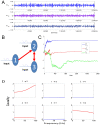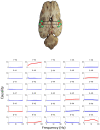A novel extended Granger Causal Model approach demonstrates brain hemispheric differences during face recognition learning
- PMID: 19936225
- PMCID: PMC2777405
- DOI: 10.1371/journal.pcbi.1000570
A novel extended Granger Causal Model approach demonstrates brain hemispheric differences during face recognition learning
Abstract
Two main approaches in exploring causal relationships in biological systems using time-series data are the application of Dynamic Causal model (DCM) and Granger Causal model (GCM). These have been extensively applied to brain imaging data and are also readily applicable to a wide range of temporal changes involving genes, proteins or metabolic pathways. However, these two approaches have always been considered to be radically different from each other and therefore used independently. Here we present a novel approach which is an extension of Granger Causal model and also shares the features of the bilinear approximation of Dynamic Causal model. We have first tested the efficacy of the extended GCM by applying it extensively in toy models in both time and frequency domains and then applied it to local field potential recording data collected from in vivo multi-electrode array experiments. We demonstrate face discrimination learning-induced changes in inter- and intra-hemispheric connectivity and in the hemispheric predominance of theta and gamma frequency oscillations in sheep inferotemporal cortex. The results provide the first evidence for connectivity changes between and within left and right inferotemporal cortexes as a result of face recognition learning.
Conflict of interest statement
The authors have declared that no competing interests exist.
Figures

 ,
,  , and
, and  for the simulated data in Toy Model 1. The initial values of the three parameters are all set to 0. The covariance matrix
for the simulated data in Toy Model 1. The initial values of the three parameters are all set to 0. The covariance matrix  is first set to decay slowly to achieve faster convergence and then set to decay faster after two hundred time points to ensure a better accuracy. D. Frequency decomposition of all kinds of relationships between the state variables. Significant causal influences are marked by red.
is first set to decay slowly to achieve faster convergence and then set to decay faster after two hundred time points to ensure a better accuracy. D. Frequency decomposition of all kinds of relationships between the state variables. Significant causal influences are marked by red.
 (without input) in our algorithms and a traditional VAR(10) model to detect the causal influence. B. The network structure of the state variables corresponding to A. Two additional causal relationships are marked by the dashed line. C. Confidence intervals of all links between units. The data is generated with Eq. (16) where
(without input) in our algorithms and a traditional VAR(10) model to detect the causal influence. B. The network structure of the state variables corresponding to A. Two additional causal relationships are marked by the dashed line. C. Confidence intervals of all links between units. The data is generated with Eq. (16) where  and
and  ,
,  are generated with normal distribution (with input). D. The network structure of the state variables corresponding to C.
are generated with normal distribution (with input). D. The network structure of the state variables corresponding to C.


Similar articles
-
Learning alters theta amplitude, theta-gamma coupling and neuronal synchronization in inferotemporal cortex.BMC Neurosci. 2011 Jun 9;12:55. doi: 10.1186/1471-2202-12-55. BMC Neurosci. 2011. PMID: 21658251 Free PMC article.
-
Large-scale neural models and dynamic causal modelling.Neuroimage. 2006 May 1;30(4):1243-54. doi: 10.1016/j.neuroimage.2005.11.007. Epub 2006 Jan 4. Neuroimage. 2006. PMID: 16387513
-
Identifying the default mode network structure using dynamic causal modeling on resting-state functional magnetic resonance imaging.Neuroimage. 2014 Feb 1;86:53-9. doi: 10.1016/j.neuroimage.2013.07.071. Epub 2013 Aug 6. Neuroimage. 2014. PMID: 23927904 Free PMC article.
-
Uncovering interactions in the frequency domain.PLoS Comput Biol. 2008 May 30;4(5):e1000087. doi: 10.1371/journal.pcbi.1000087. PLoS Comput Biol. 2008. PMID: 18516243 Free PMC article. Review.
-
Investigating effective brain connectivity from fMRI data: past findings and current issues with reference to Granger causality analysis.Brain Connect. 2012;2(5):235-45. doi: 10.1089/brain.2012.0091. Brain Connect. 2012. PMID: 23016794 Free PMC article. Review.
Cited by
-
The Impact of Alpha-Neurofeedback Training on Gastric Slow Wave Activity and Heart Rate Variability in Humans.Neurogastroenterol Motil. 2025 May;37(5):e15009. doi: 10.1111/nmo.15009. Epub 2025 Feb 17. Neurogastroenterol Motil. 2025. PMID: 39962719 Free PMC article. Clinical Trial.
-
Affective cognition and its disruption in mood disorders.Neuropsychopharmacology. 2011 Jan;36(1):153-82. doi: 10.1038/npp.2010.77. Epub 2010 Jun 23. Neuropsychopharmacology. 2011. PMID: 20571485 Free PMC article. Review.
-
Effective Connectivity Modeling for fMRI: Six Issues and Possible Solutions Using Linear Dynamic Systems.Front Syst Neurosci. 2012 Jan 18;5:104. doi: 10.3389/fnsys.2011.00104. eCollection 2011. Front Syst Neurosci. 2012. PMID: 22279430 Free PMC article.
-
Learning alters theta amplitude, theta-gamma coupling and neuronal synchronization in inferotemporal cortex.BMC Neurosci. 2011 Jun 9;12:55. doi: 10.1186/1471-2202-12-55. BMC Neurosci. 2011. PMID: 21658251 Free PMC article.
-
Attention-dependent modulation of cortical taste circuits revealed by Granger causality with signal-dependent noise.PLoS Comput Biol. 2013 Oct;9(10):e1003265. doi: 10.1371/journal.pcbi.1003265. Epub 2013 Oct 24. PLoS Comput Biol. 2013. PMID: 24204221 Free PMC article.
References
-
- Cantone I, Marucci L, Iorio F, Ricci M, Belcastro V, et al. A yeast synthetic network for in vivo assessment of reverse-engineering and modeling approaches. Cell. 2009;137:172–181. - PubMed
-
- Camacho D, Collins J. Systems biology strikes gold. Cell. 2009;137:24–26. - PubMed
-
- Zou C, Kendrick KM, Feng J. The fourth way: Granger causality is better than the three other reverse-engineering approaches. 2009. Cell http://www.cell.com/comments/S0092-8674(09)00156-1.
Publication types
MeSH terms
Grants and funding
LinkOut - more resources
Full Text Sources

